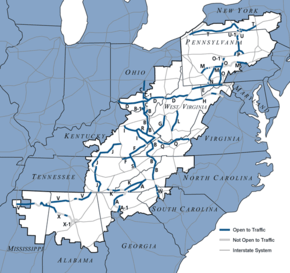Corridor B
| Appalachian Development Highway System |

Map of the Appalachian Development Highway System
|
| System information |
| Maintained by state or local governments
|
| Length: |
3,090 mi (4,970 km) |
| Formed: |
March 9, 1965 |
The Appalachian Development Highway System (ADHS) is part of the Appalachian Regional Commission in the United States. It consists of a series of highway corridors in the Appalachia region of the eastern United States. The routes are designed as local and regional routes for improving economic development in the historically isolated region. It was established as part of the Appalachian Regional Development Act of 1965, and has been repeatedly supplemented by various federal and state legislative and regulatory actions. The system consists of a mixture of state, U.S., and Interstate routes. The routes are formally designated as "corridors" and assigned a letter. Signage of these corridors varies from place to place, but where signed are often done so with a distinctive blue-colored sign.
In 1964, the President's Appalachian Regional Commission (PARC) reported to Congress that economic growth in Appalachia would not be possible until the region's isolation had been overcome. Because the cost of building highways through Appalachia's mountainous terrain was high, the region's local residents had never been served by adequate roads. The existing network of narrow, winding, two-lane roads, snaking through narrow stream valleys or over mountaintops, was slow to drive, unsafe, and in many places worn out. The nation's Interstate Highway System, though extensive through the region, was designed to serve cross-country traffic rather than local residents.
The PARC report and the Appalachian governors placed top priority on a modern highway system as the key to economic development. As a result, Congress authorized the construction of the Appalachian Development Highway System (ADHS) in the Appalachian Development Act of 1965. The ADHS was designed to generate economic development in previously isolated areas, supplement the interstate system, and provide access to areas within the region as well as to markets in the rest of the nation. The system has served its intended purpose to varying degrees of success.
...
Wikipedia

